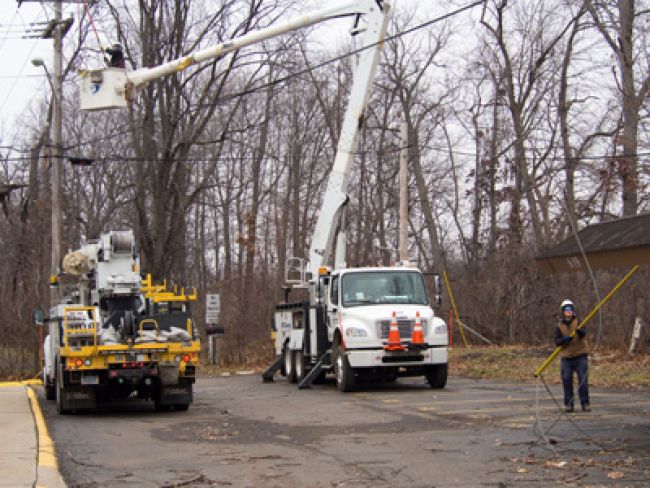
Keeping Crews Warm in Winter
Winter is approaching, and for utilities operating in the Frost Belt, keeping crews warm isn’t just a good thing to do – it’s a safety imperative.
For vehicle cab comfort, the choices fall between keeping the engine running and using the truck’s HVAC system, or using an auxiliary heater. As always, the choice depends on the fleet’s desires.
The simplest solution is to keep the engine running, but that’s a costly option for fleet managers focused on keeping down fuel costs. Idle-limiting systems help fleets get over that hurdle. With numerous choices available on the aftermarket, these systems automatically shut down the engine at a work site, periodically turning it on for a few minutes to recharge the batteries to power the PTO and hydraulics. They significantly reduce fuel use, and the length of time the engine runs can be adjusted to ensure the truck’s heater keeps the cab comfortable.
Avista Utilities, based in Spokane, Wash., is testing a system from ZeroRPM (www.zerorpm.com) that has a cab comfort setting to maintain temperatures when the truck is on-site. The system automatically starts the engine and will run an average of five to seven minutes every hour, depending on the level of heat needed, according to Evan Miller, ZeroRPM’s vice president of sales. “The system can provide full HVAC service if [the fleet] wants. There are different applications for heat,” he said.
Avista’s primary goals are to reduce fuel costs while keeping the crew’s safety at the forefront, and the ZeroRPM system suits their needs, said Greg Loew, fleet manager. “We do burn a sizable chunk of fuel a year idling vehicles, but you have to think about how to take care of the guys who are out there,” he said. “It’s a safety thing and it’s a critical thing to consider. You need systems that allow the guys to be comfortable.”
If the idle mitigation system performs well this winter, Avista will consider adding more during the next buying cycle, Loew said.
Don’t want – or need – to run the engine, even periodically? Auxiliary air and coolant heaters from companies such as Eberspaecher Climate Control Systems (www.eberspaecher.com) and Webasto (www.webasto.com) will handle cold-weather needs while saving engine use. These systems operate independently of a truck’s temperature control system and typically use a fraction of the fuel a truck would use while idling, according to the manufacturers.
If all you need to heat is the air inside the cab, auxiliary air heaters are the way to go. These are mounted inside the cab and tied into the truck’s fuel line.
Hydronic (coolant) heaters are integrated in series or parallel to the existing coolant lines and will preheat the engine and also supply warm air into the cab via the vehicle’s heat exchanger, explained John Dennehy, Eberspaecher’s vice president of marketing and communications. The heaters are mounted inside the engine compartment or along the frame rail.
Detroit-based DTE Energy uses a variety of systems to keep trucks operating and crews warm in winter temperatures that often hit below zero, said Gerard Huvaere, procurement specialist. The hydronic system from Eberspaecher (formerly Espar) heats the coolant to help engine starting, ensure cab comfort and warm the aerials’ hydraulic oils. DTE also uses Eberspaecher space heaters as well as Altec’s JEMS (Jobsite Energy Management System), an auxiliary battery-based system that provides power for job site needs and cab comfort systems.
DTE is looking for “startability and employee comfort” in its heating systems, Huvaere said. “All closed work spaces have some sort of heating.”
Crews like a system that gives them the ability to set the start time, but in the end, Huvaere said, it’s “any system that keeps them warm.”
About the Author: Jim Galligan has been covering the commercial truck transportation sector for more than 30 years and has extensive experience covering the utility fleet market. In addition to writing and editing for magazines, his background also includes writing for daily newspapers, trade associations and corporations.
*****
Selecting Auxiliary Heaters
The first decision utility fleet managers have to make when considering an auxiliary heating system is which type fits their needs: hydronic or air.
The simple answer is that if all the fleet needs to heat is the vehicle’s cab, an air heater will do the job. Air heaters consume a fraction of fuel per hour compared with an idling truck. The Air Top 2000 ST from Webasto, for example, will use about 1 gallon of fuel per 22 hours, according to the company. Air heaters also are easier to install and cost less than hydronic systems.
Size depends on the space to be heated, but John Dennehy, vice president of marketing and communications for Eberspaecher Climate Control Systems, said the company’s smaller model would be appropriate for most utility cabs.
Hydronic systems, on the other hand, are used to preheat the engine coolant, provide heat to the cab and warm the aerial hydraulics, if needed. Suppliers offer multiple sizes depending on engine sizes and the fleet’s needs, but the smaller sizes may suffice for most utility fleet needs.
The principal benefit of auxiliary heaters is lower fuel costs. Suppliers have simple fuel-saving calculators on their websites, but beyond direct fuel savings, the total cost savings from using an auxiliary heater in lieu of idling the engine may also come from longer service intervals, longer engine life and improved startability on cold mornings.

